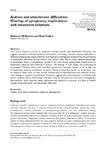Autism and attachment difficulties: overlap of symptoms, implications and innovative solutions
| dc.contributor.author | mckenzie or stancer, rebecca | |
| dc.contributor.author | dallos, rudi | |
| dc.date.accessioned | 2017-05-22T16:26:35Z | |
| dc.date.available | 2017-05-22T16:26:35Z | |
| dc.date.issued | 2017-05-22 | |
| dc.identifier.issn | 1359-1045 | |
| dc.identifier.issn | 1461-7021 | |
| dc.identifier.uri | http://hdl.handle.net/10026.1/9307 | |
| dc.description.abstract |
This article explores overlap of symptoms between autism and attachment difficulties and suggests innovative solutions based on formulation. Currently, clinicians express difficulties in differentiating between these conditions contributing to misdiagnosis. Research into the prevalence of attachment difficulties among children with autism often fails to reflect detailed knowledge of attachment theory. Consequently, studies in this area employ questionable modifications to attachment measures and methods of analysis. The findings of such studies are confusing and inconsistent. Children with autism and their parents are, however, known to be at high risk of developing insecure attachment patterns. Clinical assessments based on formulation may be helpful in these cases, as they include consideration of developmental and relational factors contributing to symptom presentation. Research suggests that where parents of children with autism establish secure relationships with their children outcomes are improved. Consequently, interventions, which improve dyadic synchrony and sensitivity of parents, are likely to benefit families living with autism and attachment difficulties. | |
| dc.format.extent | 632-648 | |
| dc.format.medium | Print-Electronic | |
| dc.language | en | |
| dc.language.iso | en | |
| dc.publisher | SAGE Publications | |
| dc.subject | Autism | |
| dc.subject | formulation | |
| dc.subject | attachment | |
| dc.subject | diagnosis | |
| dc.subject | development | |
| dc.title | Autism and attachment difficulties: overlap of symptoms, implications and innovative solutions | |
| dc.type | journal-article | |
| dc.type | Journal Article | |
| dc.type | Review | |
| plymouth.author-url | https://www.webofscience.com/api/gateway?GWVersion=2&SrcApp=PARTNER_APP&SrcAuth=LinksAMR&KeyUT=WOS:000412750400009&DestLinkType=FullRecord&DestApp=ALL_WOS&UsrCustomerID=11bb513d99f797142bcfeffcc58ea008 | |
| plymouth.issue | 4 | |
| plymouth.volume | 22 | |
| plymouth.publication-status | Published | |
| plymouth.journal | Clinical Child Psychology and Psychiatry | |
| dc.identifier.doi | 10.1177/1359104517707323 | |
| plymouth.organisational-group | /Plymouth | |
| plymouth.organisational-group | /Plymouth/Faculty of Arts, Humanities and Business | |
| plymouth.organisational-group | /Plymouth/Faculty of Arts, Humanities and Business/Plymouth Institute of Education | |
| plymouth.organisational-group | /Plymouth/Faculty of Health | |
| plymouth.organisational-group | /Plymouth/REF 2021 Researchers by UoA | |
| plymouth.organisational-group | /Plymouth/REF 2021 Researchers by UoA/UoA23 Education | |
| plymouth.organisational-group | /Plymouth/Users by role | |
| plymouth.organisational-group | /Plymouth/Users by role/Academics | |
| dc.publisher.place | England | |
| dcterms.dateAccepted | 2017-04-22 | |
| dc.rights.embargodate | 2018-05-22 | |
| dc.rights.embargodate | 2018-05-22 | |
| dc.rights.embargodate | 2018-05-22 | |
| dc.identifier.eissn | 1461-7021 | |
| dc.rights.embargoperiod | 12 months | |
| rioxxterms.versionofrecord | 10.1177/1359104517707323 | |
| rioxxterms.licenseref.uri | http://www.rioxx.net/licenses/under-embargo-all-rights-reserved | |
| rioxxterms.licenseref.startdate | 2017-05-22 | |
| rioxxterms.type | Journal Article/Review |


